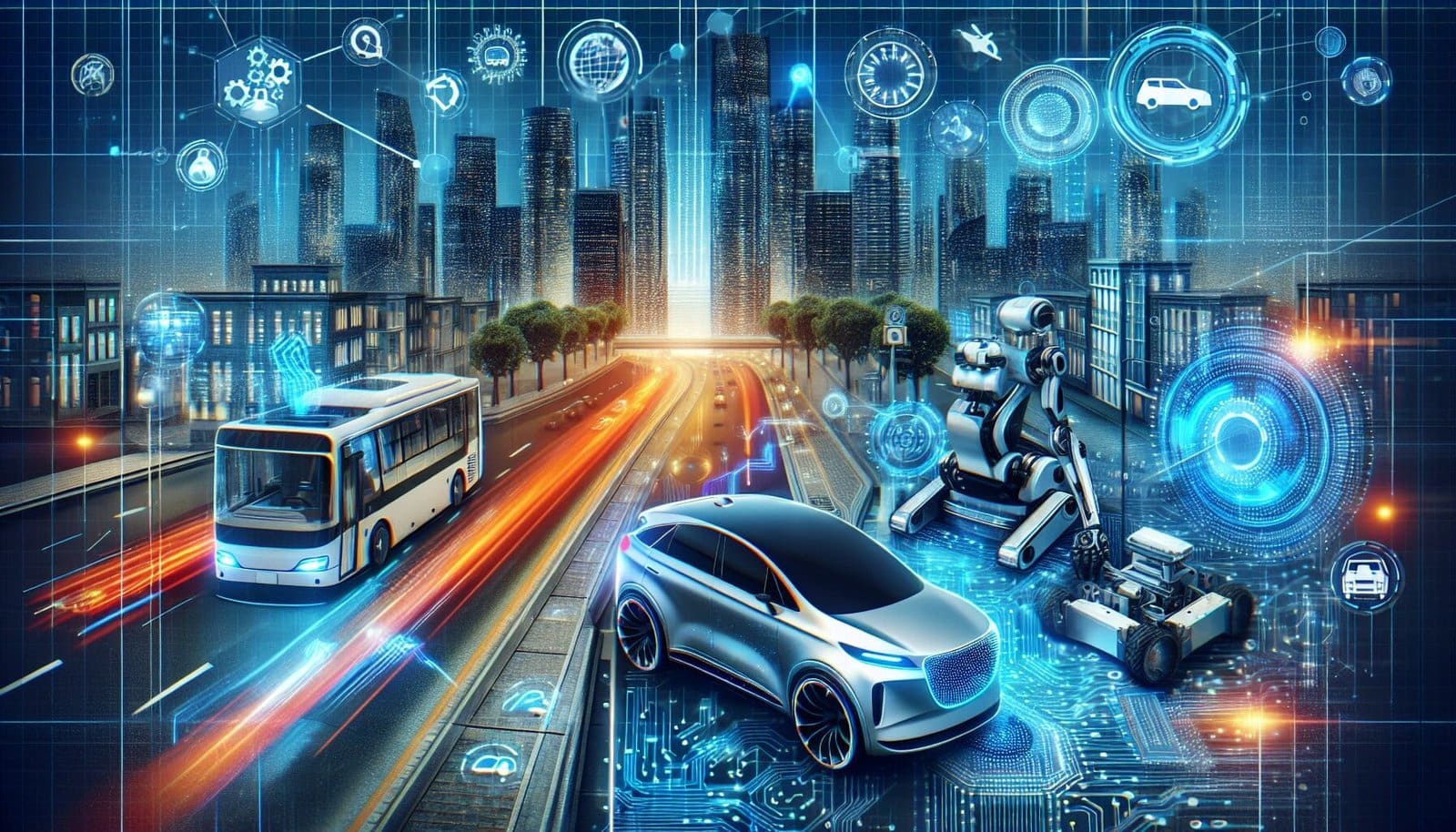Artificial intelligence is revolutionizing the transportation industry, transforming the way we travel and commute. From self-driving cars that navigate the streets with efficiency and safety, to intelligent traffic management systems that optimize traffic flow, AI is reshaping the way we move from point A to point B. With its ability to process enormous amounts of data and make real-time decisions, AI applications are enhancing the efficiency, reliability, and safety of transportation systems worldwide. In this article, we delve into the various ways AI is being utilized in transportation and the potential impact it holds for the future of our daily commute.
Challenges in Transportation
Transportation is an essential aspect of our daily lives, enabling us to travel efficiently and reach our destinations in a timely manner. However, it is not without its challenges. Let's explore some of the key challenges in transportation and how artificial intelligence (AI) is transforming the industry.
Traffic congestion
One of the biggest challenges faced by transportation systems worldwide is traffic congestion. As the number of vehicles on roads continues to rise, it becomes increasingly difficult to manage traffic flow and ensure smooth movement. AI solutions offer promising ways to tackle this issue by providing intelligent traffic management systems.
Fuel efficiency
Another significant challenge in transportation is fuel efficiency, particularly in an age where environmental concerns are at the forefront. Traditional vehicles often consume large amounts of fuel, contributing to air pollution and greenhouse gas emissions. AI technology can play a crucial role in optimizing fuel efficiency by analyzing data and making intelligent decisions regarding vehicle operations.
Safety concerns
Safety is paramount in the transportation industry, and it is necessary to address the various safety concerns associated with our roadways. Accidents and collisions pose a significant risk to both drivers and pedestrians alike. AI solutions can help enhance safety by providing collision avoidance systems, driver monitoring, and emergency assistance.
Infrastructure management
The maintenance and management of transportation infrastructure is yet another challenge that needs to be addressed. Aging roads, bridges, and tunnels require regular inspections and maintenance to ensure safe and efficient travel. AI-powered predictive maintenance systems can detect signs of wear and tear, enabling timely repairs and reducing downtime.
Artificial Intelligence (AI) Solutions
The advancement of AI technology offers promising solutions to overcome the challenges faced in the transportation industry. Let's delve into some of the specific AI solutions that are transforming transportation systems worldwide.
Intelligent traffic management systems
Intelligent traffic management systems utilize AI algorithms to monitor real-time traffic conditions and optimize traffic flow. By analyzing data from various sources such as cameras, sensors, and GPS devices, these systems can make informed decisions regarding traffic signal timings, lane management, and route diversions. This helps reduce congestion and improve overall travel times.
Optimized route planning
AI-powered route planning systems take into account various factors such as traffic conditions, road closures, and even weather conditions to calculate the most efficient routes for vehicles. By considering these multiple factors and providing real-time updates, these systems help drivers save time and fuel by avoiding congested areas or roadblocks.
Automated vehicles
The concept of automated vehicles has gained significant attention in recent years. From self-driving cars to autonomous trucks and even automated public transportation, AI technology has the potential to revolutionize the way we travel. Automated vehicles utilize a combination of sensors, machine learning algorithms, and real-time data analysis to navigate roads, make intelligent decisions, and ensure passenger safety.
Predictive maintenance
Predictive maintenance is another area where AI is making a significant impact. By analyzing data from onboard sensors and historical maintenance records, AI systems can detect early signs of potential failures or maintenance needs. This enables transportation agencies to proactively address maintenance issues, reduce downtime, and improve overall performance.

Intelligent Traffic Management Systems
Intelligent traffic management systems are at the forefront of AI applications in transportation. These systems aim to optimize traffic flow, reduce congestion, and enhance overall travel experience. Let's explore some of the key features and benefits of intelligent traffic management systems.
Real-time traffic monitoring
Intelligent traffic management systems employ a network of cameras, sensors, and other data collection devices to monitor traffic conditions in real-time. By analyzing this data, the systems can identify areas of congestion, accidents, or roadblocks, and make necessary adjustments to improve traffic flow.
Traffic flow optimization
By utilizing AI algorithms, intelligent traffic management systems can analyze data and make predictions about traffic patterns. This allows the systems to optimize traffic flow by adjusting signal timings, modifying lane configurations, or suggesting alternate routes to minimize congestion and delays.
Dynamic traffic signal control
Traditional traffic signal timings are often predetermined and fixed, leading to potential inefficiencies during times of varying traffic demands. Intelligent traffic management systems leverage AI technology to dynamically adjust signal timings based on real-time traffic conditions. This helps reduce wait times at intersections, improve traffic flow, and enhance the overall driving experience.
Optimized Route Planning
Optimized route planning is a key application of AI in transportation that focuses on calculating the most efficient routes for vehicles. By considering various factors such as traffic conditions, road closures, and even weather conditions, AI-powered systems can help drivers save time, fuel, and make informed decisions while navigating roadways.
Efficient route calculation
AI-powered route planning systems employ sophisticated algorithms to calculate the most efficient routes for vehicles. These algorithms take into account real-time traffic data, historical traffic patterns, and other relevant factors to provide drivers with optimal route suggestions. By avoiding congested areas or roadblocks, drivers can not only save time but also reduce fuel consumption and emissions.
Consideration of multiple factors
Optimized route planning systems go beyond considering just traffic conditions. They also take into account other factors such as road closures, construction zones, and even weather conditions. By considering these multiple factors, drivers can be guided towards routes that are not only efficient in terms of travel time but also safe and reliable.
Real-time updates
One of the key benefits of optimized route planning systems is the ability to provide real-time updates. As traffic conditions change, the systems can dynamically adjust route suggestions to ensure drivers reach their destinations using the most optimal and up-to-date routes. This helps drivers avoid unexpected delays and make informed decisions based on real-time information.

Automated Vehicles
Automated vehicles, including self-driving cars, autonomous trucks, and automated public transportation, are some of the most exciting applications of AI in transportation. The concept of vehicles operating without human intervention has the potential to revolutionize the way we travel and transform transportation systems worldwide.
Self-driving cars
Self-driving cars, equipped with a range of sensors, cameras, and AI algorithms, are capable of navigating roads and making intelligent decisions without human input. These vehicles can analyze real-time traffic data, detect obstacles, and adjust their speed and route accordingly. Self-driving cars have the potential to make travel safer, reduce accidents, and increase overall road efficiency.
Autonomous trucks
Autonomous trucks have the potential to transform the logistics and transportation industry. These vehicles can autonomously transport goods, reducing the need for human drivers and potential human errors. By using AI algorithms and sensors, autonomous trucks can navigate highways, maintain safe distances, and optimize fuel consumption, ultimately enhancing efficiency and reducing transportation costs.
Public transportation automation
Automation is not limited to personal vehicles; it also extends to public transportation systems. Autonomous buses and trains can improve the efficiency and reliability of public transportation services. By leveraging AI technology, these vehicles can optimize routes, adjust schedules based on real-time demand, and enhance the overall passenger experience.
Predictive Maintenance
Maintaining transportation infrastructure is critical to ensure safe and efficient travel. The implementation of AI-powered predictive maintenance systems allows transportation agencies to address maintenance needs proactively, detect potential failures, and reduce downtime.
Early detection of maintenance needs
AI-powered predictive maintenance systems analyze data from various sources, including onboard sensors and historical maintenance records. By continuously monitoring equipment, these systems can detect early signs of potential failures or maintenance needs. Early detection allows transportation agencies to schedule maintenance activities, replace faulty equipment, or repair infrastructure before major issues occur.
Reduced downtime
Timely maintenance and repairs lead to reduced downtime for transportation infrastructure. By addressing maintenance needs proactively, transportation agencies can minimize disruptions to travel and ensure reliable transportation services for the public. Reduced downtime also leads to cost savings, as emergency repairs are often more expensive and time-consuming.
Improved performance
Predictive maintenance not only reduces downtime but also improves the overall performance of transportation infrastructure. By proactively addressing maintenance needs, the lifespan of equipment and infrastructure components can be extended. This leads to improved reliability, increased efficiency, and enhanced safety for both passengers and operators.
Safety Enhancements
Safety is a top priority in the transportation industry. AI technology offers a range of solutions to enhance safety and mitigate the risks associated with transportation.
Collision avoidance systems
AI-powered collision avoidance systems utilize sensors, cameras, and advanced algorithms to detect potential collisions and take appropriate action to avoid accidents. These systems can analyze the surrounding environment in real-time and alert drivers or even intervene directly to prevent collisions. By providing an extra layer of safety, collision avoidance systems help reduce accidents and save lives.
Driver monitoring
AI technology can be used to monitor driver behavior and detect signs of fatigue, distraction, or any other factors that may compromise safety. By analyzing data from onboard sensors and cameras, AI systems can alert drivers to potential risks, provide feedback on driving behavior, and ensure that drivers are alert and focused on the road.
Emergency assistance
In the event of emergencies or accidents, AI-powered systems can provide immediate assistance. By detecting incidents through real-time monitoring and analysis, these systems can automatically alert emergency services, provide accurate location information, and even facilitate communication between those involved in the incident. This ensures prompt response and assistance, potentially saving lives and minimizing injuries.
Sustainable Transportation
In an era of growing environmental concerns, sustainable transportation is a significant focus area. AI technology can contribute to reducing emissions, improving fuel efficiency, and promoting the adoption of electric and hybrid vehicles.
Emissions reduction
AI-powered transportation systems can help reduce emissions by optimizing traffic flow, reducing congestion, and minimizing idle time for vehicles. Additionally, AI algorithms can analyze data to identify areas with high pollution levels and implement targeted solutions to mitigate environmental impacts.
Efficient fuel consumption
By analyzing real-time data and considering various factors such as traffic conditions and road topology, AI-powered systems can optimize fuel consumption for vehicles. This leads to reduced fuel consumption, lower operating costs, and a smaller carbon footprint.
Electric and hybrid vehicles
The adoption of electric and hybrid vehicles plays a crucial role in achieving sustainable transportation. AI technology can support the growth of these vehicles by providing optimized route planning, ensuring efficient charging infrastructure, and analyzing data to improve battery performance. AI algorithms can also help determine the most suitable locations for charging stations, making electric vehicles more accessible and convenient for drivers.
Enhanced Public Transportation
Public transportation plays a vital role in urban areas, providing an efficient and sustainable mobility option for the masses. AI technology offers several applications to enhance public transportation services and improve the overall passenger experience.
Intelligent dispatching systems
AI-powered dispatching systems optimize the deployment of public transportation vehicles based on real-time demand. These systems analyze data from various sources, including passenger counts, traffic conditions, and historical patterns, to ensure that vehicles are deployed efficiently and meet the demand effectively. This reduces waiting times, improves service reliability, and enhances the overall passenger experience.
Demand-responsive services
AI technology enables demand-responsive public transportation services, allowing routes and schedules to be dynamically adjusted based on passenger demand. By analyzing real-time data and considering factors such as population density, events, and commute patterns, transportation agencies can provide flexible and customized services that meet the needs of passengers efficiently.
Smart ticketing
AI-powered smart ticketing systems simplify the ticketing process for passengers and enhance the overall efficiency of public transportation services. These systems can suggest the most suitable ticket options based on passenger travel patterns, analyze usage data to optimize fare structures, and provide seamless integration with various modes of transportation. This ensures a convenient and user-friendly experience for passengers and encourages the use of public transportation.
Conclusion
Artificial intelligence has the power to revolutionize the transportation industry, addressing various challenges and transforming the way we travel. From intelligent traffic management systems to optimized route planning, automated vehicles, and predictive maintenance, AI solutions offer opportunities to enhance efficiency, improve safety, promote sustainability, and provide better public transportation services. As AI technology continues to advance, we can look forward to a future where transportation systems are safer, more efficient, and more sustainable, ultimately benefiting us all.








